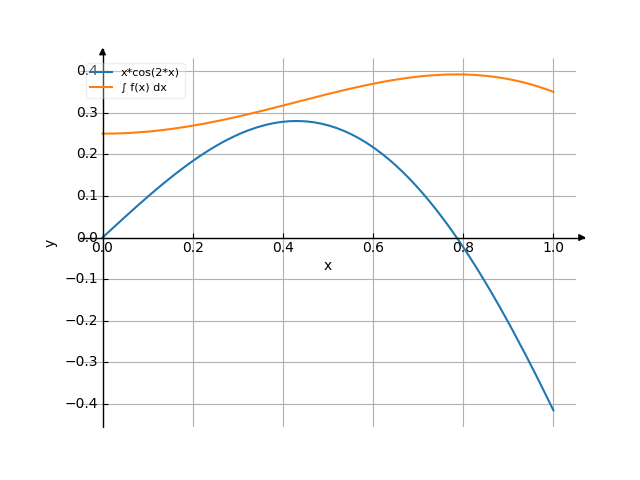Integral of xcos2x dx
The solution
Detail solution
-
Use integration by parts:
∫udv=uv−∫vdu
Let u(x)=x and let dv(x)=cos(2x).
Then du(x)=1.
To find v(x):
-
Let u=2x.
Then let du=2dx and substitute 2du:
∫4cos(u)du
-
The integral of a constant times a function is the constant times the integral of the function:
∫2cos(u)du=2∫cos(u)du
-
The integral of cosine is sine:
∫cos(u)du=sin(u)
So, the result is: 2sin(u)
Now substitute u back in:
2sin(2x)
Now evaluate the sub-integral.
-
The integral of a constant times a function is the constant times the integral of the function:
∫2sin(2x)dx=2∫sin(2x)dx
-
There are multiple ways to do this integral.
Method #1
-
Let u=2x.
Then let du=2dx and substitute 2du:
∫4sin(u)du
-
The integral of a constant times a function is the constant times the integral of the function:
∫2sin(u)du=2∫sin(u)du
-
The integral of sine is negative cosine:
∫sin(u)du=−cos(u)
So, the result is: −2cos(u)
Now substitute u back in:
−2cos(2x)
Method #2
-
The integral of a constant times a function is the constant times the integral of the function:
∫2sin(x)cos(x)dx=2∫sin(x)cos(x)dx
-
There are multiple ways to do this integral.
Method #1
-
Let u=cos(x).
Then let du=−sin(x)dx and substitute −du:
-
The integral of a constant times a function is the constant times the integral of the function:
∫(−u)du=−∫udu
-
The integral of un is n+1un+1 when n=−1:
∫udu=2u2
So, the result is: −2u2
Now substitute u back in:
−2cos2(x)
Method #2
-
Let u=sin(x).
Then let du=cos(x)dx and substitute du:
-
The integral of un is n+1un+1 when n=−1:
∫udu=2u2
Now substitute u back in:
2sin2(x)
So, the result is: −cos2(x)
So, the result is: −4cos(2x)
-
Add the constant of integration:
2xsin(2x)+4cos(2x)+constant
The answer is:
2xsin(2x)+4cos(2x)+constant
The answer (Indefinite)
[src]
/
| cos(2*x) x*sin(2*x)
| x*cos(2*x) dx = C + -------- + ----------
| 4 2
/
42xsin(2x)+cos(2x)
The graph
1 sin(2) cos(2)
- - + ------ + ------
4 2 4
42sin2+cos2−41
=
1 sin(2) cos(2)
- - + ------ + ------
4 2 4
−41+4cos(2)+2sin(2)
Use the examples entering the upper and lower limits of integration.


![Find the integral of y = f(x) = xcos2x dx (x co sinus of e of 2x) - with detailed solution [THERE'S THE ANSWER!] xcos2x](/media/krcore-image-pods/176/hash/indefinite/3/71/d559acb25937cb90114639667ee7c.png)
 Integral of 1/sqrt(x^2+1)
Integral of 1/sqrt(x^2+1)
 Integral of 1/√(x+1)
Integral of 1/√(x+1)
 Integral of x(x-1)(x-2)
Integral of x(x-1)(x-2)
 Integral of x^3*exp(x^2)
Integral of x^3*exp(x^2)
 xcos2x
xcos2x